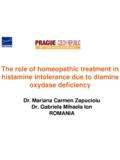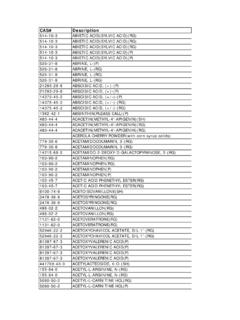Transcription of Amino Acid Production
1 Amino acid ProductionBackgroundMSGL-LysineL-Threoni neL-Aspartate & L-AlanineAspartameOther Amino AcidsControversiesThe Amino acid industry provides illustrations of how onerationally selects and manipulates microorganisms forproducing a marketable product. It also provides someinsight into unforeseen problems that may arise with large Amino acid business is a multi-billion dollar enterprise. All twenty Amino acids are sold, albeiteach in greatly different quantities (Table 1). Amino acids are used as animal feed additives (lysine,methionine, threonine), flavor enhancers (monosodium glutamic, serine, aspartic acid ) and asspecialty nutrients in the medical field. Glutamic acid , lysine and methionine account for themajority, by weight, of Amino acids sold. Glutamic acid and lysine are made by fermentation;methionine is made by chemical synthesis.
2 The major producers of Amino acids are based in Japan,the US, South Korea, China and microbe-based industries have their origins in traditions that go back hundreds or thousands ofyears. The Amino acid industry has its roots in food preparation practices in Japan. Seaweeds hadbeen used for centuries there and in other Asian countries as a flavoring ingredient. In1908, KikunaeIkeda of Tokyo Imperial University isolated the flavor enhancing principle from the seaweed konbu (alsospelled kombu, Laminaria japonica; related to kelp) as crystals of monosodium glutamate (MSG).Adding MSG to meat, vegetables and just about any other type of prepared food makes it savory, aproperty referred to as umami. Soon after Ikeda s discovery, and recognizing the market potential ofMSG, Ajinomoto Co. in Japan began extracting MSG from acid -hydrolyzed wheat gluten or defattedsoybean and selling it as a flavor Production of MSG via fermentation grew out of the ashes of WWII in Japan.
3 Around 1957,Japanese researchers led by S. Kinoshita at Kyowa Hakko Kogyo Co. isolated soil bacteria that produced largeamounts of glutamic acid . Producing strains were found by inoculating soil isolates in a grid pattern onduplicate Petri plates. The colonies were allowed to grow and one set of duplicates was killed with UVirradiation. The killed plate was overlaid with soft agar containing a Leuconostoc mesenteroides. Since required glutamic acid for growth, it only grew in the vicinity of colonies that had excretedglutamate. Potential glutamate producers were then picked from the duplicate, unkilled, of the Actinobacteria in the genus Corynebacterium (originally named Micrococcus glutamicus) werethe most effective producers. Over the years, various glutamate-producing bacteria have been isolated andclassified as Arthrobacter, Brevibacterium, or as members of other genera, but recent work has shown thatalmost all of these strains belong to the genus Corynebacterium.
4 Wild-type cultures produced up to 10 g/lglutamic acid . Yields were quickly improved by process engineering and by developing over-producingmutants. Yields are now in excess of 100 g per productionfermentors. Thevolume of each is63,420 gallons andthe height is about100 ft tall. Hofu,Japan.( )The isolation of bacterialglutamate-producers led to thedevelopment of large-scalemanufacture of MSG from cheapsugar and ammonia rather thanfrom more expensive extracts ofplants or animals. In the early1960s, workers at the samecompany found that C. glutamicumhomoserine auxotrophs (see below)produced lysine thus providing thefirst viable fermentation processfor lysine Production . Today thesebacteria produce well over1,000,000 metric tons of MSG and600,000 metric tons of general approaches areused today for making aminoacids: direct chemical synthesis,fermentation and bioconversionusing enzymes.
5 Choosing between processes depends on available technology, costs of raw material,market prices and sizes, cost of running fermentation versus synthesis reactions, and theenvironmental impact of the process itself. Table 1 illustrates the major processes as of 1996. Theprocesses have not changed very much since then, but the amounts made have increased at a rate ofabout 2-5% per acids are consumed in a variety of markets. The largest by volumeis the food flavoring industry. MSG, alanine, aspartate, arginine are allused to improve the flavor of food. The basis of our ability to enjoy thetaste of Amino acids is rooted in evolution. Animals require certain aminoacids for growth and nutrition. Specific taste receptors on the humantongue have been found that are G-protein coupled receptors responsive tomany of the 20 L- but not D- Amino acids.
6 For human receptors, thestrongest response is for glutamate, thus providing a biochemical link towhat cooks have known for centuries. Interestingly, inosine mono-phosphate (IMP), another well-known flavor enhancing nucleotide alsosold commercially, greatly increases the response of the receptor to second largest consumer of Amino acids is the animal feed , methionine, threonine, tryptophan and others improve thenutritional quality of animal feeds by supplying essential Amino acids thatmay be in low abundance in grain. Using lysine in animal feedimproves the quality of the feed as much as adding 20% soy meal. Inaddition, by limiting the added Amino acid supplements to those requiredby the animal, some of the excess ammonia made via deamination reactions that is normally excretedto the environment is eliminated.
7 The addition of microbially-produced Amino acids has alsoincreased with the onset of Mad Cow syndrome (BSE), a disease traced to feed supplementscontaining animal 1. Estimated global Production of Amino acids (1996)* Amino acidAmount(ton/y)ProcessUsesL-glutamate1 ,000, enhancerD, L. Methionine350,000 ChemicalFood , Feed HCL250, SupplementGlycine22,000 ChemicalPharm., soy sauceL-Phenylalanine8,000 Ferm., SynthesisAspartameL-Aspartic acid7,000 EnzymaticAspartame, , supplementL-Cysteine1,500 Extraction, , L Alanine1,500 ChemicalFlavor, sweetenerL- Glutamine1, , , Tryptophan500 Ferm., EnzymaticFeed suppl., Leucine500 Ferm., ExtractionPharmaceuticalsL - Tyrosine120 ExtractionPharmaceuticals*From Ikeda, M. 2003. Adv. Biochem. Eng. Biotech. 79 acids in an IVstock Travasol EssentialLeucine730 mgIsoleucine600 mgLysine(HCl)580 mgValine580 mgPhenylalanine560 mgHistidine480 mgThreonine420 mgMethionine400 mgTryptophan180 gProline680 mgSerine500 mgTyrosine40 mgAcetate88 mEqChloride40 mEqpH 6 (5-7); Total aa = 10 gFinally, the pharmaceutical industry uses a variety of Amino acids for making intravenous nutrientsolutions for pre- and post-operative care (see Table 2).
8 These mixtures account for a smallpercentage of the total volume of Amino acids sold each year, but the requirement that they be highlypurified provides a value-added component. In addition to these uses, Amino acids are used asspecialty chemicals in laboratories, in the manufacture of artificial sweeteners (aspartame) and inmany other is the most abundant free Amino acid in bacterial cytoplasm. Nevertheless, in order to be useful,glutamate producers must do two things well: they must overproduce glutamate in excess of their normalmetabolic needs, and they must excrete it into culture broth. The precise mechanism by which C. glutamicumdoes these things is still not completely understood despite over forty years of study. Some physiological traits,however, are clearly involved. These include biotin auxotrophy of producing strains, a marked decrease in -ketoglutarate dehydrogenase activity during Production , and a predilection for exporting glutamate, perhaps viaa specific of the original glutamate-excreting strains were biotin auxotrophs, and growing in biotin deficientmedium was found to trigger glutamate Production .
9 Biotin is a cofactor (a vitamin ) used by enzymes thatcarboxylate substrates. One such enzyme is acetyl-CoA carboxylase that converts Acetyl-CoA + CO2 toMalonyl-CoA in the first step of fatty acid biosynthesis. Biotin auxotrophs growing in biotin deficient mediumwere proposed to have altered membranes due to suboptimal fatty acid biosynthesis. Supporting the notion ofaltered permeability is the observation that growth at higher temperatures, or including detergents or cell-wallbiosynthesis inhibitors like penicillin in the growth medium can also trigger levels of -ketoglurate dehydrogenase during Production may also be linked to membrane corynebacteria, the enzyme has three activities on two peptides: the -kg dehydrogenase + dihydrolipoamideS-succinyltransferase peptide and the dihydrolipoamide dehydrogenase peptide.
10 The latter is shared withpyruvate dehydrogenase and is likely to be membrane bound and thus prone to being affected by trigger factorsthat alter membrane -ketoglurate dehydrogenase catalyzes a step in the TCA cycle, the cycle is largely incomplete duringglutamate Production , a circumstance requiring that pools of oxaloacetate be filled, as carbon is lost throughglutamate. Anaplerotic enzymes replace OAA; these enzymes include pyruvate carboxylase (Rxn. 1), malicenzyme (Rxn. 2), PEP carboxylase (Rxn. 3) and glyoxylate pathway pyruvate + CO2 + ATP oxaloacetate + ADP + Pi2. pyruvate + CO2 + NADPH malate + NADP+ + H+3. phosphoenol pyruvate + CO2 oxaloacetate + PiThe actual contribution of each anaplerotic enzyme or pathway depends on the growth conditions, productionphase and a host of interacting metabolic signals.








